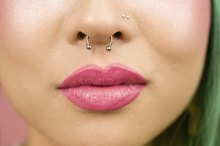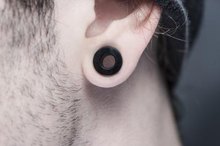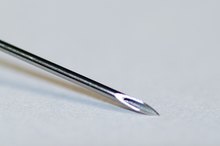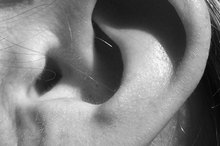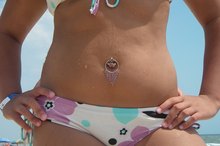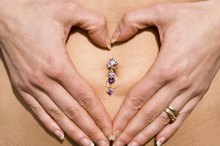What Are The Signs & Symptoms of Rejecting Belly Button Rings?
When your body rejects a belly button piercing, the jewelry moves to the surface of the skin and eventually comes out 2. This can be really frustrating after you've paid for a piercing and endured the discomfort of healing. There are some steps you can take to prevent your body from rejecting the navel piercing. Proper piercing technique and the right kind of jewelry reduce the chance of rejection 12. Recognizing the early signs of rejection might help you save the piercing, and will prevent more serious scarring 1.
Choose The Right Jewelry
When a piercing is rejected, it's because your body is pushing out a foreign object, just as it would a splinter.
Choosing the right jewelry for your navel piercing will make it less likely for your skin to reject it 2.
Make sure the size and shape of the jewelry is right for the size of your navel. A ring that is too small might not sit deeply enough to stay in, and a too-large ring can rub up excessively against the waistband of your pants. Rings that are too heavy also tend to come out. When you get your navel piercing, the Association of Professional Piercers cautions that there should be at least 5/16-inch of skin between the entry and exit holes of the piercing.
The material the jewelry is made of can also cause piercing rejection 12. Use only rings or barbells made of high quality surgical steel that contains very little nickel.
Even people who aren't allergic to nickel can have a reaction to nickel in low-quality piercing jewelry. If you know you're allergic to nickel or other metals, get titanium or niobium jewelry. Symptoms of an allergy to the piercing are an itchy, red rash, and the hole around the jewelry might appear much larger than the jewelry 2.
- When a piercing is rejected, it's because your body is pushing out a foreign object, just as it would a splinter.
- When you get your navel piercing, the Association of Professional Piercers cautions that there should be at least 5/16-inch of skin between the entry and exit holes of the piercing.
Prevent Infection
What Is the Bump Next to My Nose Ring?
Learn More
All naval piercings are red, swollen and tender right after having them done. If this irritation continues for more than a week, or if there is pus or a bad-smelling discharge, you could have an infection. Infected piercings might be an early sign of rejection. Be careful to follow the after-care instructions given to you by your piercer. Wash the piercing twice a day in mild soap and water, and turn the jewelry to clean and rinse the inside 2. Use an antiseptic cleanser on the piercing as directed by the piercer. Don't touch the navel piercing unless you are cleaning it, and don't let other people touch it either. Absolutely avoid going swimming until the piercing is completely healed, which usually takes about six weeks.
- All naval piercings are red, swollen and tender right after having them done.
- Don't touch the navel piercing unless you are cleaning it, and don't let other people touch it either.
Rejection Symptoms
**It is not uncommon for a navel piercing to migrate slightly during or after healing.
** This can happen because of a metal allergy, or because the jewelry is just trying to move to a place where it isn't disturbed by the natural movement of your skin. If you notice your jewelry migrating, get it checked out by a piercer to see if it is normal movement or if you should change the jewelry.
On a healed piercing, rejection may or may not be painful 1. Although the skin over the jewelry doesn't always look irritated, it might be red, flaky or hard and callused-looking. You might notice the amount of skin between the entry and exit holes is decreasing.
You might also notice the skin around the jewelry looks shiny or tight. Sometimes you might even be able to see the jewelry through your skin. If you think your body is rejecting the piercing, get it removed as soon as possible. As the skin thins, your risk the jewelry getting yanked out by accident, and you can have a serious scar or cleft in your skin if a piercing is left to fall out on its own 2.
- It is not uncommon for a navel piercing to migrate slightly during or after healing.
- As the skin thins, your risk the jewelry getting yanked out by accident, and you can have a serious scar or cleft in your skin if a piercing is left to fall out on its own 2.
Related Articles
References
- The Piercing Urge: The Dreaded Rejection
- The Body Jewelry Shop: Common Body Piercing Problems
- American Family Physicians: Complications of Body Piercing
- London Borough of Brent: Guidelines For Body Piercing Good Practices
- National Conference of State Legislatures. Tattooing and body piercing | state laws, statutes and regulations. March 13, 2019.
- Koenig, L. M., & Carnes, M. (1999). Body Piercing: Medical Concerns with Cutting-Edge Fashion. Journal of General Internal Medicine, 14(6), 379–385.
- Palo Alto Medical Foundation, Body Piercing
- National Conference of State Legislatures. Tattooing and body piercing | state laws, statutes and regulations. March 13, 2019.
- American Academy of Pediatrics. HealthyChildren.org. Body piercings, teens & potential health risks: AAP report explained. Updated September 18, 2017.
- Johns Hopkins All Children’s Hospital. Adolescent tattoos, body piercings and body modifications. November 21, 2017.
- Koenig, L. M., & Carnes, M. (1999). Body Piercing: Medical Concerns with Cutting-Edge Fashion. Journal of General Internal Medicine, 14(6), 379–385.
- Palo Alto Medical Foundation, Body Piercing
